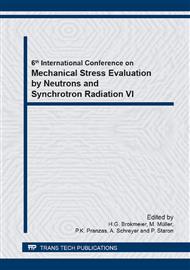p.143
p.149
p.155
p.161
p.167
p.173
p.181
p.187
p.193
Investigation of Residual Stress/Strain and Texture in a Large Dissimilar Metal Weld Using Synchrotron Radiation and Neutrons
Abstract:
Bi-metallic piping welds are frequently used in light water nuclear reactors to connect ferritic steel pressure vessel nozzles to austenitic stainless steel primary cooling piping systems. An important aspect for the integrity of such welds is the presence of residual stresses. Measurement of these residual stresses presents a considerable challenge because of the component size and because of the material heterogeneity in the weld regions. The specimen investigated here was a thin slice cut from a full-scale bi-metallic piping weld mock-up. A similar mock-up had previously been investigated by neutron diffraction within a European research project called ADIMEW. However, at that time, due to the wall thickness of the pipe, stress and spatial resolution of the measurements were severely restricted. One aim of the present investigations by high energy synchrotron radiation and neutrons used on this thin slice was to determine whether such measurements would render a valid representation of the axial strains and stresses in the uncut large-scale structure. The advantage of the small specimen was, apart from the easier manipulation, the fact that measurement times facilitated a high density of measurements across large parts of the test piece in a reasonable time. Furthermore, the recording of complete diffraction patterns within the accessible diffraction angle range by synchrotron X-ray diffraction permitted mapping the texture variations. The strain and stress results obtained are presented and compared for the neutron and synchrotron X-ray diffraction measurements. A strong variation of the texture pole orientations is observed in the weld regions which could be attributed to individual weld torch passes. The effect of specimen rocking on the scatter of the diffraction data in the butt weld region is assessed during the neutron diffraction measurements.
Info:
Periodical:
Pages:
193-199
Citation:
Online since:
November 2013
Authors:
Price:
Сopyright:
© 2014 Trans Tech Publications Ltd. All Rights Reserved
Share:
Citation:


